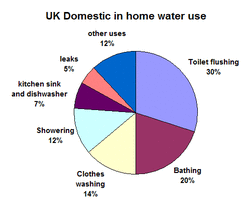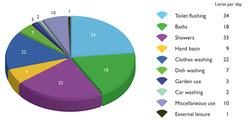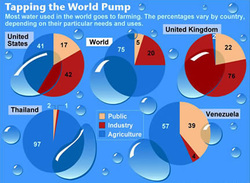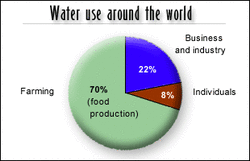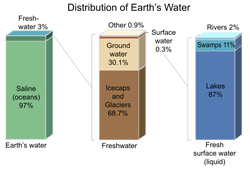Facts on usage and availability withing UK & Worldwide
UK
Each person in the UK uses 150 litres of water a day. This takes into account cooking, cleaning, washing and flushing. This has been rising by 1% a year since 1930. This consumption level is not sustainable in the long-term.
A running tap uses 6 litres of water a minute, a shower can use anywhere between 9 – 45 litres per minute, a hosepipe uses as much as 1000 litres per hour.
Toilet flushing accounts for 30% of our daily water use – with old toilets using as much as 14 litres per flush compared to new dual flush models which use as little as 2.6 and 4 litres per flush.
Fixing a dripping tap can save as much as 5000 litres a year – if everyone in the UK fixed their dripping taps we would save enough water to supply 120,000 for one day
World Water supply and distribution
Food and water are two basic human needs. However, global coverage figures from 2002 indicate that, of every 10 people:
§ 5 have a connection to a piped water supply at home (in their dwelling, plot or yard);
§ 3 make use of some other sort of improved water supply, such as a protected well or public standpipe;
§ 2 are unserved;
§ In addition, 4 out of every 10 people live without improved sanitation.
At Earth Summit 2002 governments approved a Plan of Action to:
Halve by 2015 the proportion of people unable to reach or afford safe drinking water. The Global Water Supply and Sanitation Assessment 2000 Report (GWSSAR) defines "Reasonable access" to water as at least 20 liters per person per day from a source within one kilometer of the user’s home.
Halve the proportion of people without access to basic sanitation. The GWSSR defines "Basic sanitation" as private or shared but not public disposal systems that separate waste from human contact.
§ In 2025, water shortages will be more prevalent among poorer countries where resources are limited and population growth is rapid, such as the Middle East, Africa, and parts of Asia. By 2025, large urban and peri-urban areas will require new infrastructure to provide safe water and adequate sanitation. This suggests growing conflicts with agricultural water users, who currently consume the majority of the water used by humans.
§ The more developed countries of North America, Europe and Russia will not see a serious threat to water supply by the year 2025, not only because of their relative wealth, but more importantly their populations will be better aligned with available water resources.
§ North Africa, the Middle East, South Africa and northern China will face very severe water shortages due to physical scarcity and a condition of overpopulation relative to their carrying capacity with respect to water supply. Most of South America, Sub-Saharan Africa, Southern China and India will face water supply shortages by 2025; for these latter regions the causes of scarcity will be economic constraints to developing safe drinking water, as well as excessive population growth.
§ 1.6 billion people have gained access to a safe water source since 1990.
§ The proportion of people in developing countries with access to safe water is calculated to have improved from 30 percent in 1970 to 71 percent in 1990, 79 percent in 2000 and 84 percent in 2004.
§ In 60% of European cities with more than 100,000 people, groundwater is being used at a faster rate than it can be replenished.
Each person in the UK uses 150 litres of water a day. This takes into account cooking, cleaning, washing and flushing. This has been rising by 1% a year since 1930. This consumption level is not sustainable in the long-term.
A running tap uses 6 litres of water a minute, a shower can use anywhere between 9 – 45 litres per minute, a hosepipe uses as much as 1000 litres per hour.
Toilet flushing accounts for 30% of our daily water use – with old toilets using as much as 14 litres per flush compared to new dual flush models which use as little as 2.6 and 4 litres per flush.
Fixing a dripping tap can save as much as 5000 litres a year – if everyone in the UK fixed their dripping taps we would save enough water to supply 120,000 for one day
World Water supply and distribution
Food and water are two basic human needs. However, global coverage figures from 2002 indicate that, of every 10 people:
§ 5 have a connection to a piped water supply at home (in their dwelling, plot or yard);
§ 3 make use of some other sort of improved water supply, such as a protected well or public standpipe;
§ 2 are unserved;
§ In addition, 4 out of every 10 people live without improved sanitation.
At Earth Summit 2002 governments approved a Plan of Action to:
Halve by 2015 the proportion of people unable to reach or afford safe drinking water. The Global Water Supply and Sanitation Assessment 2000 Report (GWSSAR) defines "Reasonable access" to water as at least 20 liters per person per day from a source within one kilometer of the user’s home.
Halve the proportion of people without access to basic sanitation. The GWSSR defines "Basic sanitation" as private or shared but not public disposal systems that separate waste from human contact.
§ In 2025, water shortages will be more prevalent among poorer countries where resources are limited and population growth is rapid, such as the Middle East, Africa, and parts of Asia. By 2025, large urban and peri-urban areas will require new infrastructure to provide safe water and adequate sanitation. This suggests growing conflicts with agricultural water users, who currently consume the majority of the water used by humans.
§ The more developed countries of North America, Europe and Russia will not see a serious threat to water supply by the year 2025, not only because of their relative wealth, but more importantly their populations will be better aligned with available water resources.
§ North Africa, the Middle East, South Africa and northern China will face very severe water shortages due to physical scarcity and a condition of overpopulation relative to their carrying capacity with respect to water supply. Most of South America, Sub-Saharan Africa, Southern China and India will face water supply shortages by 2025; for these latter regions the causes of scarcity will be economic constraints to developing safe drinking water, as well as excessive population growth.
§ 1.6 billion people have gained access to a safe water source since 1990.
§ The proportion of people in developing countries with access to safe water is calculated to have improved from 30 percent in 1970 to 71 percent in 1990, 79 percent in 2000 and 84 percent in 2004.
§ In 60% of European cities with more than 100,000 people, groundwater is being used at a faster rate than it can be replenished.
